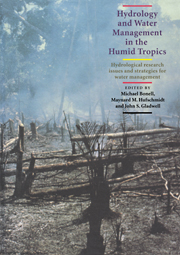 Hydrology and Water Management in the Humid Tropics
Hydrology and Water Management in the Humid Tropics Book contents
- Frontmatter
- Contents
- List of Authors
- Foreword by Federico Mayor, Director-General, UNESCO
- Preface
- Cartographic Credit
- Acknowledgements
- SECTION I INTRODUCTION
- 1 The Objectives and Structure of this Book
- SECTION II HUMID TROPICS SETTING
- SECTION III REGIONAL HYDROLOGY
- SECTION IV PHYSICAL PROCESSES
- SECTION V PHYSICAL PROCESSES – HUMAN USES: THE INTERFACE
- SECTION VI MANAGEMENT ISSUES
- SECTION VII APPENDICES
- Place index
1 - The Objectives and Structure of this Book
Published online by Cambridge University Press: 23 December 2009
- Frontmatter
- Contents
- List of Authors
- Foreword by Federico Mayor, Director-General, UNESCO
- Preface
- Cartographic Credit
- Acknowledgements
- SECTION I INTRODUCTION
- 1 The Objectives and Structure of this Book
- SECTION II HUMID TROPICS SETTING
- SECTION III REGIONAL HYDROLOGY
- SECTION IV PHYSICAL PROCESSES
- SECTION V PHYSICAL PROCESSES – HUMAN USES: THE INTERFACE
- SECTION VI MANAGEMENT ISSUES
- SECTION VII APPENDICES
- Place index
Summary
During the last decade, increasing international attention has been directed towards the environmental problems of the humid tropics, with the focus on the fate and management of the surviving tropical rain forest. In terms of water management (also termed water resource management in this volume), several rigorous reviews concerning the hydrological effects of tropical forest conversion to other land uses have emerged (Hamilton with King, 1983; Hamilton, 1988; Bruijnzeel, 1989, 1990) with particular emphasis on the changes in water yield and related land management issues connected with soil and nutrient loss.
The possible impacts of large-scale conversion of forests on climate have also been elevated in research priority within the Amazon Basin. Of particular interest are the changes in the land surface's energy balance and water vapour transfer. This new attention has led to the establishment of more ambitious field experiments in the Basin in conjunction with remote sensing. The data obtained from both sources are being used to calibrate General Circulation Models (GCMs) (Shuttleworth, et al., 1991).
These developments, however, only cover a relatively narrow part of the spectrum of water management issues. Within the developed world, the remaining problems have received less publicity, based on the false perception that being the humid tropics, the supply of potable water is more than adequate to meet the needs of the region. As a later presentation by Manton & Bonell (this volume) will outline, the distribution of tropical rainfall can still be highly variable over space and time, arising from various mechanisms that disrupt the atmospheric pressure patterns. Consequently, droughts are not unknown.
- Type
- Chapter
- Information
- Hydrology and Water Management in the Humid TropicsHydrological Research Issues and Strategies for Water Management, pp. 3 - 10Publisher: Cambridge University PressPrint publication year: 1993
- 1
- Cited by
